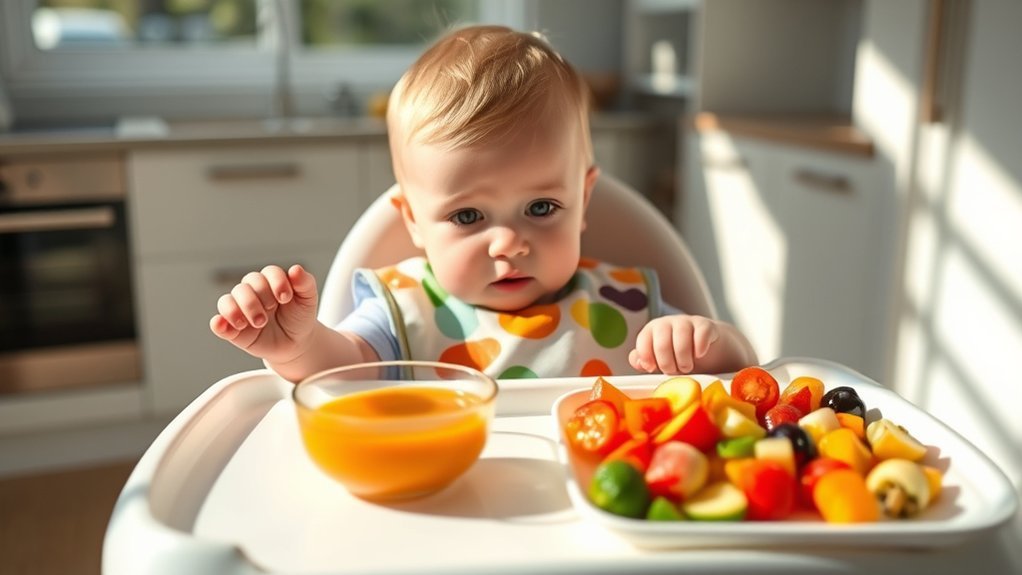When it comes to choosing between purees and baby-led weaning (BLW), it’s essential to pay attention to your baby’s cues. You’ll notice signs of readiness or discomfort that can guide your decision. For instance, gagging might be normal with purees, but constant gagging could signal something else. Similarly, in BLW, your baby’s reactions can reveal their preferences. Understanding these symptoms can lead to a smoother feeding journey, but what exactly should you be looking for?
Understanding Purees: Benefits and Challenges
When you start your baby’s journey into solid foods, understanding the benefits and challenges of purees can help you make informed choices. Purees offer a smooth texture that’s easy for your baby to swallow, reducing the risk of choking. They also allow you to introduce a variety of flavors and nutrients, ensuring your little one gets essential vitamins. However, changing from purees to more textured foods might take time, as some babies can become accustomed to the smooth consistency. Additionally, making homemade purees can be time-consuming, but it allows you to control ingredients. Balancing convenience and nutrition is key, so consider your lifestyle and your baby’s needs when deciding how to approach solid foods.
Baby-Led Weaning: An Overview
Baby-led weaning (BLW) empowers you to let your little one explore solid foods at their own pace, promoting independence and self-regulation. This approach allows babies to choose their food, encouraging healthier eating habits as they grow. By skipping purees, you’re fostering fine motor skills and hand-eye coordination while creating a positive mealtime environment.
Here’s a quick comparison of BLW and traditional weaning:
| Aspect | Baby-Led Weaning |
|---|---|
| Food Texture | Whole pieces of food |
| Parental Role | Guide and supervise |
| Mealtime Experience | Interactive and fun |
Choosing BLW can be a rewarding experience for both you and your baby, setting the stage for lifelong healthy eating habits.
Developmental Signs Indicating Readiness for Solid Foods
As your baby grows, you’ll notice specific developmental signs that indicate they’re ready to plunge into solid foods. Look for them showing interest in what you eat, reaching for your food, or opening their mouth when food approaches. Your baby should also sit up with support, demonstrating good head and neck control. Another key sign is the ability to move food from the front of their mouth to the back, which indicates they can handle different textures. If they’re around six months old and exhibiting these behaviors, they’re likely ready for solids. Remember, each child is unique, so trust your instincts and consult your pediatrician if you have any concerns about starting solid foods.
Symptoms to Watch for in Puree Feeding
Many parents wonder what signs to look for when feeding their little ones purees. It’s essential to be aware of how your baby responds during mealtime. Here are some symptoms to watch for:
- Gagging: Occasional gagging is normal, but persistent gagging can indicate discomfort.
- Refusal to Eat: If your baby consistently turns away or pushes the spoon away, they may not be ready.
- Coughing: Frequent coughing might suggest that the puree is too thick or not suitable.
- Facial Expressions: Watch for signs of distress or dislike; they can communicate dissatisfaction.
- Excessive Spitting: If your baby spits up more than usual, it could signal that something’s amiss.
Stay attentive to these cues, as they can help guide your feeding journey.
Reactions and Cues During Baby-Led Weaning
When introducing solid foods through baby-led weaning, it’s essential to observe your little one’s reactions and cues closely. Pay attention to their facial expressions; a scrunched face might indicate dislike, while wide eyes can signal curiosity. Notice how they interact with food—if they grasp it enthusiastically or bring it to their mouth, they’re likely ready to explore. Watch for signs of discomfort, like gagging or turning away, which can indicate the food or texture isn’t suitable yet. Remember, it’s normal for your baby to make a mess; this is part of the learning process. Trust your instincts, and be patient. Each baby is unique, and understanding their cues will help create a positive experience during this exciting stage.
Frequently Asked Questions
Can I Mix Purees With Baby-Led Weaning?
Yes, you can mix purees with baby-led weaning! Combining both methods can enhance your baby’s experience, offering variety and helping them develop essential skills. Just make certain foods are age-appropriate and safe for your little one.
What Age Is Best for Starting Solid Foods?
The best age to start solid foods is around six months. At this age, your baby’s digestive system is ready, and they can sit up with support, showing interest in food. Trust your instincts!
Are There Allergies to Watch for in Purees?
Yes, about 6-8% of children experience food allergies. When introducing purees, watch for reactions to common allergens like peanuts, eggs, and dairy. Always consult your pediatrician for guidance on safe introduction practices.
How Do I Transition From Purees to Solids?
To shift from purees to solids, gradually introduce soft, mashed foods. Offer small pieces of ripe fruits or cooked vegetables. Encourage self-feeding, and watch for your baby’s cues to guarantee they’re ready and comfortable.
What Tools Are Best for Baby-Led Weaning?
You’ll find tools like soft-tipped spoons, silicone mats, and easy-grip utensils essential for baby-led weaning. These help create a safe, enjoyable experience, encouraging your little one’s independence while fostering a love for food!
Conclusion
Ultimately, whether you choose purees or baby-led weaning, being attuned to your baby’s needs is essential. Watch for signs of readiness, listen to their reactions, and respect their preferences. Embrace the journey, stay patient, and celebrate each small victory. Feeding should be a positive experience, fostering a love for food while ensuring your little one feels safe and supported. Trust your instincts, adapt as needed, and enjoy this wonderful phase of exploration together.
